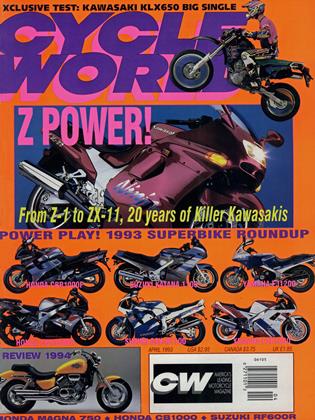KLX650 vs. HONDA XR650L
CW COMPARISON
A QUESTION OF PRIORITIES
BUILDING A DUAL-PURPOSE motorcycle is a study in the art of compromise. How street-oriented, how dirt capable, do you make it? Until recently, the answer from all the manufacturers was to bias design heavily towards road riding in an attempt to attract buyers to the dwindling dual-purpose segment of the market. That didn’t work, and now the pendulum is swinging in the other direction as dual-purpose bikes become more offroad worthy. Prime examples are the new Kawasaki KLX650 and the Honda XR650L, introduced last year as an early-release 1993 model.
Cycle World liked the XR650L so much it was named Best DualPurpose Bike of the Year. How does the KLX650 stack up against such stiff competition?
The answer, as always, depends on you and the type of riding you do. In many ways, these bikes are quite similar. Both displace 650cc and both are equipped with The Button-electric starting-the best addition to big-bore dual-purpose bikes since unbreakable fenders. Both bikes are biased towards the dirt side of the D-P equation, with the XR-L using an XR600R frame, and the KLX using a perimeter frame just
like that of its dirt-only KLX650R sister bike, itself a derivative of Kawasaki’s successful KX125 and 250 motocross frames. But the Honda takes its off-road duties more seriously than does the Kawasaki. The XR-L’s suspension is identical to that of the XR600R: a cartridge fork with adjustable compression damping, and a large-bodied, remote-reservoir shock that is fully adjustable. The only alterations are stronger springs needed to support the L’s additional 50-pound load of street gear. XR600R wheels, hubs, disc brakes and aluminum swingarm are standard on the XR-L.
Although based on Kawasaki’s new R-model 650, the KLX was detuned somewhat when it made the jump to dual-purpose mode. Its inverted fork is non-adjustable, and a thoroughly unimpressive shock lacking any kind of damping adjustment was substituted for the R’s multi-adjustable rear damper. A cush-drive rear hub was added to lessen impact to the gearbox; the KLX received a 17-inch rear wheel instead of the R’s 18-ineher; and a steel swingarm 1.5 inches longer than the aluminum arm of the R was fitted.
In all, Honda’s version of a newstyle dual-purpose bike weighs some 27 pounds less than Kawasaki’s, and the XR-L’s honest-to-goodness offroad suspension gobbles up terrain at any speed a rider is brave enough to push a 330-pound motorcycle. With a better rear shock, the new Kawasaki would have a fighting chance offroad, but as delivered, the Honda will outrun it every time.
The tables turn when only street riding is concerned. With a seat height almost 2 inches lower than the Honda’s, the Kawasaki provides surer footing at stop lights. At times, the XR-L can short and top heavy, while th KLX650, with its lower seat height, longer wheelbase and wet-sump engine (the XR-L has a dry-sump engine and carries its engine oil in the frame’s backbone and downtube), pitches around less on sion more planted. In terms of output the KLX’s liquidcooled, twin-cam engine makes 18 percent more power than the Honda’s air-cooled, single-cam motor (39 horsepower vs. 33 horsepower), and the KLX produces slightly less vibration at freeway speeds.
Simply put, then, the Honda is a better dirtbike, the Kawasaki is a better streetbike. Figure out your priorities and you’ll know which one is right for you.
 View Full Issue
View Full Issue
More From This Issue
-
 Up Front
Up FrontGreen Machines
April 1993 By David Edwards -
 Leanings
LeaningsYou Ain't Goin' Nowhere
April 1993 By Peter Egan -
 TDC
TDCSpring To Action
April 1993 By Kevin Cameron -
 Letters
LettersLetters
April 1993 -
 Roundup
RoundupYamaha To Go Standard?
April 1993 By Jon F. Thompson -
 Roundup
RoundupBimota Presses On With Gp Streetbike
April 1993 By Alan Cathcart





